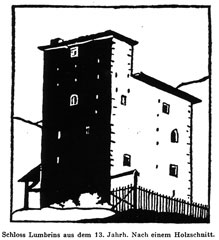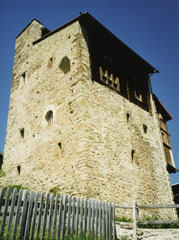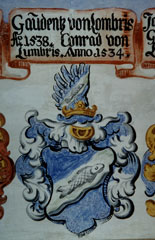


[This narrative contains excerpts from Ils Landrechters Della Famiglia de Lumerins (Lumbriser), a 1928 document, written in Romansh, that describes the early history of the family in Graubünden, Switzerland. I am grateful to Ciril Lombriser of Chur for the translation into English, which I have edited and augmented with material in brackets.]
The Lumerins family lived in Lumbrein, and is one of the oldest families in the country. They were feudal lords (Feudalherren), and ruled over the people around the castle of Lumbrein. The name of the village was also their own.
Rugo and Richpert de villa de Lumarine seem to be the first recorded members of the family; they lived in the 9th century.
[The family built a "fortress-like" manor house (Schloß) on the southeast edge of Lumbrein in the 13th century. It has been in the possession of the Capol family since the early 16th century. The Schloß, as it appeared in an early woodcut, is shown in panel one below. Panel two shows the Schloß as it appears today (well, in 1997, anyway).]
 |
 |
 |
The family was apparently displaced from their position as feudal lords through the Belmont. Under Bishops d'Ehingen and Hartmann they became episcopal ministers in Sagogn and Lumnezia, where the family practiced this duty as late as the 14th century.
Cundrau de Lumerins was abbot of the monastery of Disentis from 1235-1247. In 1240 he donated the altar of the saints Placi and Sigisbert (founder of the monastery of Disentis) to the cathedral of Chur. On the left side in the cathedral of Chur he had a grave beside the Lords of Strassberg.
Johannes de Lumarins lived from about 1320 to 1387. He was called "the elder" to distinguish him from his son with the same name. On 24 November 1384 he created a foundation which specified that every year on St. Catrina's day, six priests had to preach six masses for his ancestors and his descendants. From 1384 to 1385 Johannes was a minister to the Lords of Sax-Mesauc in Lumnezia. Together with his sons Hans, Cristoffel, Hainrich, and Martin, he is mentioned in a receipt dated 1385, which shows that goods from Rietberg were sold to the bishop of Chur. These goods were an inheritance from an uncle, Hans da Rietberg.
Hans de Lumarins lived from about 1360 to 1430. He was also called Hans de Lumbrins II. On the receipt dated 1388 mentioned above, he was described as "governor" (Vogt) in Lumnezia. He took this duty from his father. In the years 1388, 1391, and 1400 he was a minister of the Lords of Sax-Mesauc in Lumnezia. He was the first Landrichter (district judge) of the Gray League, which was founded in 1424. For this duty he was nominated by his Lord Hans da Sax-Mesauc. He was therefore present at the swearing of the oath under the maple tree in Trun.
Heinric de Lumbrins, son of Johannes ("the elder"), bought the Löwenberg estate at Schluein from the Lords of Werdenberg-Sargans in 1429.
Benedetg (Benedikt) de Lumerins lived from about 1410 to 1470. He was mentioned in a document from October 1423, in which he received two courts in Sagogn from Bishop Johann in Chur. In 1451 he was chosen as the second Landrichter from the Lumerins family. In the same year he was also a minister to the Lords of Sax-Mesauc in Lumnezia. Benedetg was the brother of Magdalena Fontana, née Lumerins. She was the mother of Benedetg Fontana, the army leader at the Calvenschlacht.
[The Calvenschlacht (battle of the Calven Gorge) was fought on 22 May 1499 during the Swabian War, when the Holy Roman Emperor Maxmilian I attempted to reestablish control throughout his domain by attacking Graubünden. He was defeated by the Swiss Confederation, and the Peace of Basel (22 September 1499) served as an unofficial recognition of Swiss independence. A statue of Benedikt Fontana in Chur commemorates this battle.]
Wilhelm de Lumerins lived from about 1450 to 1510. In 1472 he served as magistrate to the Lords of Sax in Lumnezia. He was the Landrichter in 1483.
Hans de Lumerins (also "de Lumbrins") lived from about 1460 to 1530. He was called "the younger" (il giuven) and was the son of Benedetg de Lumerins. He became Landrichter in 1540. He was the last Landrichter of the Lumerins from Lumbrein. Hans worked as an aide to the bishop in Lumnezia in the years 1493, 1497, 1505, 1507, and 1527. From 1513 to 1514 he was a commissioner in the Valtelina. Together with his cousin Benedetg Fontana he fought in the Calvenschlacht.
Albin de Lumerins lived from about 1480 to 1540. He was the son of Hans ("the younger"). According to the archives in Lumbrein he served the church in 1507. In 1519 he was a commissioner in the Valtelina and the only "Oberländer" in episcopal ministry in Oberhalbstein in 1521. This duty was filled by Benedetg Fontana. With him the line of the Lumerins from Lumbrein disappears from the political scene.
Gudegn de Lumbrins lived from about 1410 to 1470. According to the archives of Trun he was the first Lumbrins who lived in that village. His wife was named Anna and his sons were Hug, Badrut, Ragett, and Claus.
Hug de Lumbrins lived from about 1440 to 1510. In 1492 he appears as the first Pannermeister of the Cadi in a judgment over a dispute concerning the pasture border between Trin and Tumein. In 1495 he also was chosen as Landrichter.
Badrutt de Lumbrins lived from about 1450 to 1520. In 1500 he was the district president (Kreispräsident) of the Cadi.
Neither Ragett de Lumbrins (ca. 1450-1520) nor Claus de Lumbrins (ca. 1460-1520) performed any official duties. Claus married a woman named Jakna and they had two sons, who were Cundrau and Gudegn.
Cundrau de Lumbrins lived from about 1480 to 1540. He married Barbara Cecilia da Sax-Mesauc. They had a son, Cundrau, and a daughter, Cristina. He was a district president (Kreispräsident) of the Cadi four times between 1520 and 1536. In 1522 Cundrau worked as a steward (Hofmeister) at the abbey in Disentis/Mustér. This was during the Reformation. On 25 June 1529, as district president, Cundrau was manager of the delegates from the Three Leagues at the negotiations for the first peace of Kappel. He served as Landrichter in 1534/35. [His name can be seen at the bottom of the coat of arms in panel three above.]
Gudegn de Lumbrins lived from about 1490 to 1549. He and his wife Afra lived in a house in Zignau, which was built on the ground walls of the Phiesel castle. Between 1516 and 1532 he was several times Kreispräsident of the Cadi. He led the men from the Cadi during the War of Muosch against governor (Vogt) Gion Giachen de Medici in 1531. Between 1537 and 1549 he was Landrichter five times. [His name can be seen at the top of the coat of arms in panel three above.] In 1549 he was a delegate of the Gray League from the Three Leagues. The mission of the delegates was to sign a contract with the king of France, Heinric II, at Baden. When the delegates returned from Baden there was a storm on Lake Zürich and the ship sank. Gudegn drowned, but two men drifted to the bridge in Rapperswil and were saved.
Around 1650 Martin Mudest Lumbriser moved from Lumbrein to Sumvitg (Somvix). There he married Maria Jacum Tuor. His son Geli received the civil rights of Sumvitg in 1706. From this line there were several Podestaten in the Veltlin and other district presidents of the Cadi. The line in Sumvitg, with the present-day surname Lombris, descends from this man.
The Lombriser family's coat of arms (Wappen) has changed over time. In its earliest form, it consisted of a green field with a vertical silver stream running down the center.
A later version appears in the former residence of the Abbots of Disentis in Trun (now the Museum Sursilvan). In 1700, the artist Fridoln Eggert, a monk, painted on the walls of the Landrichtersaal the heraldic shields of all the district judges of the Gray League who had served from 1424 to 1700, including Cundrau and Gudegn de Lumbrins, mentioned earlier. As can be seen in panel three above, their coat of arms depicts a blue field with a green stream running across it, rising diagonally from left to right. A silver fish is depicted in the stream.
| Index | Sources |